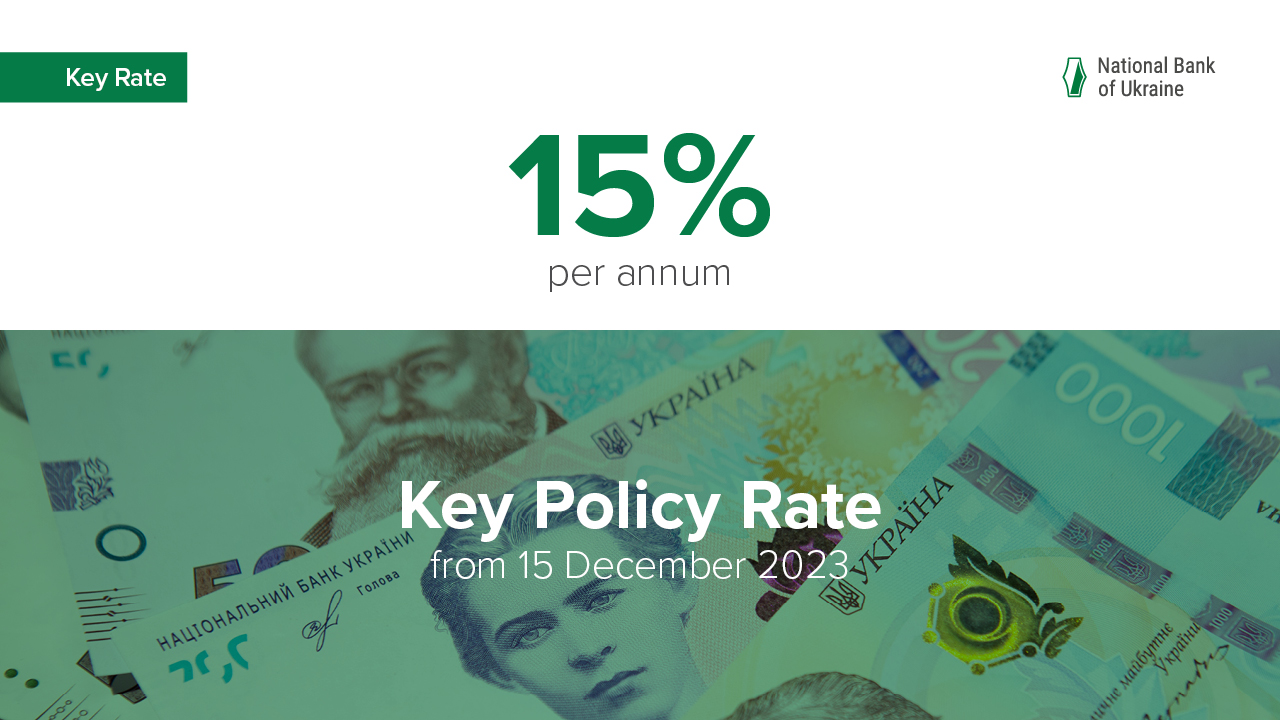The Board of the National Bank of Ukraine has decided to cut the key policy rate from 16% to 15% effective 15 December 2023. This decision comes along with a decline in inflation and an improvement in inflation expectations, which will contribute to sustained attractiveness of hryvnia savings instruments.
In November, inflation declined to 5.1%, which was even faster than expected
The slowdown in inflation was driven by an increase in supply of food products from the new harvest as well as by an improvement in expectations brightened by the stronger hryvnia exchange rate. The stronger hryvnia also made core inflation decline faster than expected by the NBU. The NBU estimates inflation readings in December to remain close to the current levels. At the same time, inflation risks are persisting due to logistical problems at western borders and effects from large harvests waning faster (especially for vegetables).
The adaptation to managed flexibility of the exchange rate has been successful
The FX market remained sustainable after the introduction of the new exchange rate regime. Demand for foreign currency spiked only in the first days of the managed flexibility regime, and the balance of supply and demand improved after that. This also led to a decrease in the NBU’s net FX sales. In November, the balance of the NBU’s interventions was USD 2.5 billion, which was less than in previous months. As declared, every day the NBU covered the structural deficit of foreign currency, letting the hryvnia exchange rate sway in either direction influenced by changes in supply and demand on the FX market.
The new exchange rate regime resulted in a notable pickup on the interbank market, in particular by boosting volumes of transactions between the banks without the NBU’s participation. An increase in the depth of the FX market is important for reducing its susceptibility to situational factors and for improving exchange rate sustainability.
Moreover, the link strengthened between the cash and cashless segments of the FX market. Lifting restrictions for the banks and non-bank financial institutions to sell cash foreign currency to households contributed to further minimization of the spread between the rate on the cash market and the official exchange rate.
The NBU will remain active on the FX market to meet the structural demand and smooth out exchange rate fluctuations
The structural deficit of foreign currency will persist due to the consequences of the war. This will require the NBU to maintain an active presence on the FX market – both to meet the structural demand for foreign currency and to smooth out significant exchange rate fluctuations. As proper macroeconomic preconditions are created, the NBU will increase the flexibility of the exchange rate and step up its role as the means for the economy to adapt to external and internal shocks.
In addition, the NBU will continue to take measures to support the attractiveness of hryvnia savings instruments: deposits and domestic government debt securities. This will restrain demand for foreign currency and, together with FX interventions, will help maintain exchange rate sustainability. Such policy will allow keeping inflation moderate throughout the next year.
International reserves remain sufficient for supporting exchange rate sustainability
The NBU’s international reserves were close to USD 39 billion as of the end of November. In the past several months, the reserves decreased only slightly, despite a less regular arrival of external financing. The current volume of international reserves is much larger compared to both the start of this year and the period before the full-scale russian invasion.
Although the way the full-scale war develops remains the key risk to inflation dynamics and economic development, risks to international aid have also increased
Great uncertainty over the duration and intensity of the full-scale war persists. As before, the NBU predicts that there will not be any significant reduction in security risks until 2025. If hostilities last longer, the NBU expects additional economic losses and stronger inflationary pressures.
The risks to the regularity of external financial assistance have also materialized in part. That said, the NBU expects that external financing will become regular again in the near future. The reasons for optimism include, among other things, the successful completion of the second review of the Extended Fund Facility (EFF) for Ukraine, as well as assurances in that regard from Ukraine’s international partners, which is an integral part of this program.
The NBU also takes into account the high adaptability of Ukrainian businesses and households to wartime challenges, which largely offsets the negative effects of certain risks. An example of this is the much faster-than-expected increase in exports via the new sea corridor. The expansion of maritime logistics has fully replaced the suspended "grain corridor" and mitigates the effects of the trade and transportation restrictions imposed by some EU countries.
Taking into account the successful adaptation of market participants to the new exchange rate regime, the further decline in inflation and improved inflation expectations, the NBU Board decided to cut the key policy rate and other interest rates on NBU operations by 1 pp.
Previous steps taken to ease interest rate policy resulted in a moderate decline in nominal market interest rates on hryvnia instruments, which was in line with the NBU’s expectations. More specifically, the weighted average interest rate on household term deposits with maturities of three months or more dropped, to 14.7% in November. Yields on domestic government debt securities on the secondary market fell to 16% to 19.7%, depending on their maturity.
At the same time, given the decline in inflation and improved expectations, interest rates on hryvnia instruments even rose slightly in real terms. As a result, hryvnia instruments continue to be an attractive instrument for savings.
Since a cut in the key policy rate will not pose any risks to the attractiveness of hryvnia savings amid a further decline in inflation, improved inflation expectations, and the FX market’s successful adaptation to the new exchange rate regime, the NBU is continuing its interest rate easing cycle. Starting from 15 December 2023, the key policy rate and the interest rate on the NBU’s main operation – the overnight placement of certificates of deposit – will be 15%. The interest rate on three-month certificates of deposit and that on refinancing loans will be also cut by 1 pp, to 19% and 21% respectively.
Looking ahead, the NBU stands ready to adapt its interest rate policy flexibly, factoring in changes in the balance of risks to exchange rate sustainability and inflation.
Any further changes in the key policy rate will depend on the development of inflationary processes, the state of the FX market, how regularly international aid arrives, how sufficient international aid is, how security risks evolve, and other factors.
The decision to cut the key policy rate, to 15% per annum, was approved by NBU Board Decision on the key policy rate No. 448, dated 14 December 2023, which will come into effect on 15 December 2023.
A summary of the discussion by Monetary Policy Committee members that preceded the approval of this decision will be published on 25 December 2023.
The next meeting of the NBU Board on monetary policy issues will be held on 25 January 2024, according to the confirmed and published schedule.


